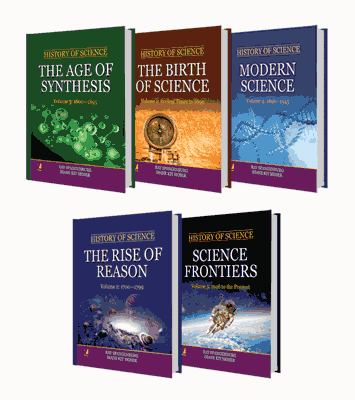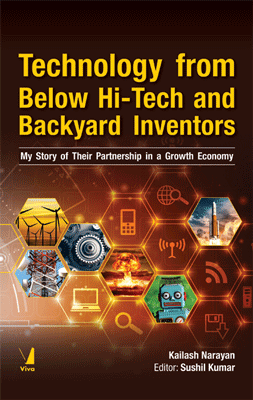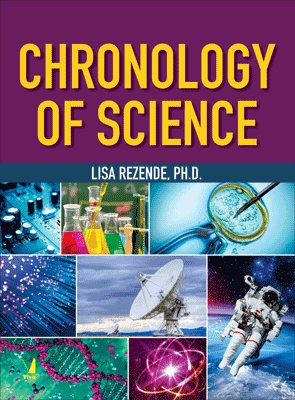History of Science, 5 Volume Set
History of Science, 5 Volume Set
₹4,495.50 ₹4,995.00 Save: ₹499.50 (10%)
Go to cart-
Out of Stock
ISBN: 9788130934051
Bind: Hardbound
Year: 2017
Pages: 1040
Size: 158 x 242 mm
Publisher: Facts On File Inc.
Published in India by: Viva Books
Exclusive Distributors: Viva Books
Sales Territory: India, Nepal, Pakistan, Bangladesh, Sri Lanka
History of Science is a comprehensive multivolume series that explores the progress of science through discovery, innovation, collaboration, and experimentation. Since the publication of the original series a decade ago, authors Ray Spangenburg and Diane Kit Moser have expanded and updated their coverage to include more information on women in science, new photographs and line illustrations, and a “science and society” section devoted to the interchange among science and cultural-social mores and historical events.
Volume I: The Birth of Science: Ancient Times to 1699
Volume II: The Rise of Reason: 1700-1799
Volume III: The Age of Synthesis: 1800-1895
Volume IV: Modern Science: 1896-1945
Volume V: Science Frontiers: 1946 to the Present
Target Audience:
People interested in History of Science.
The Birth of Science: Volume 1: Ancient Times to 1699
The Birth of Science: Ancient Times to 1699 is a thorough examination of the scientific ideas developed by the early Greeks, the advances of the Middle Ages and the Renaissance, and the momentous discoveries of the Scientific Revolution in the 17th century. The book details the work of the “giants” of science (including Aristotle, Copernicus, and Isaac Newton); contributions of diverse cultures, especially Islamic science; historical insights from such sources as the correspondence between Galileo and his daughter; and the records of Isaac Newton.
Contents: PART I: Precursors of Science: From Ancient Times to the Middle Ages • Ancient Peoples: Observation, Measurement, and Mythology • Time and Place: About 500 B.C.E. in Greece Babylonia and Egypt • The Ancient Greeks: New Ways of Looking at Things • Aristotle-And “Why Things Happen” • From Aristotle to the High Middle Ages: (322 B.C.E.-1449 C.E.) • Archimedes and Direct Observation • Women in Science: Mathematics-Not Just for Men • The Cosmos • Side Roads of Science: Astrology and Its Roots • Hipparchus and Ptolemy • The Rise of Islamic Science • The Scholastics: Frozen in Time • Growth of Science in India and China • PART II: The Scientific Revolution in the Physical Sciences • The Universe Turned Outside-In: Copernicus, Tycho, and Kepler • Copernicus and the Birth of a Revolution • Tycho Brahe: Observer of the Stars • Johannes Kepler and the Elliptical Orbit • Legacy of a Triad • A “Vast and Most Excellent Science”: Galileo and the Beginnings of Method • William Gilbert: Pioneer of Experimental Science • Discovering Laws of Motion • The Telescope: Seeing Is Believing • Lippershey and the Invention of the Telescope • Women in Science: The Missing Astronomers • Giordano Bruno: Martyr for Science” • Argument and Capitulation: The Trial • Boyle, Chemistry, and Boyle's Law • Chemistry's Beginnings • The Genius of County Cork • Shared Knowledge • An Absence of Gases • Understanding Gases • Building Blocks of Chemistry: Methods and Elements • Newton, the Laws of Motion, and the “Newtonian Revolution” • The Great Synthesizer • Fontenelle: The First Professional Popular Science Writer • Three Laws of Motion • The Nature of Light • Sir Isaac Newton, Hero of an Age • PART III: The Scientific Revolution in the Life Sciences • The Anatomists: From Vesalius to Fabricius • Galen's Mixed Legacy • Vesalius the Anatomist • The Seeds of Change • Paracelsus, Pharmaceuticals, and Medicine • Paracelsus, the Physician • Paracelsus, the Alchemist • Sanctorius (Santorio Santorio) • The Heart of the Matter • Early Ideas About Blood • Big Ideas in a Small Book • Harvey and Animal Reproduction • Blood and Air • The Amazing Microscopic World • Malpighi and the Capillary • Grew Views Plant Structure • Giovanni Borelli and the Mechanical Body • Swammerdam Examines Insects • Hooke, Master Illustrator • Leeuwenhoek's “Wretched Beasties • Understanding the Diversity of Life • The Vegetable Lamb on a Stalk • Francesco Redi and Spontaneous Generation • Konrad Gesner, Natural Historian • Fossils • John Ray and the Species Concept • PART IV: Science, Society, and the Scientific Revolution • The Seventeenth Century: A Time of Transition • John Dee: Scientist and Magician • Royal Intrigues • A Time of Intertwined Beliefs • Secrecy and Power • Conclusion: An Evolving Legacy - The Scientific Method
The Rise of Reason: Volume 2: 1700-1799
The Rise of Reason: 1700”1799 is a fascinating account that follows the progress of scientific discovery and thought from the early 1700s to the 19th century. The book details the Enlightenment in Europe and concurrent trends in other cultures; the work of the “giants” of physical and life sciences, including Kant, Franklin, and Lamarck; observations of the Earth, the Sun, and the solar system; precursors to modern evolutionary theory; and the popularization of reason.
Contents: PART I: The Physical Sciences in the 18th Century • Exploring the New Solar System • The Battle of the Bulge • Women in Science: Laura Bassi, Physicist of Bologna • The Transit of Venus and Captain James Cook • Stars, Galaxies, and Nebulas • Of Stars and Comets • The Remarkable John Goodricke • New Views of the Universe • Pierre-Simon Laplace • Charles Messier and His Catalog • Teamwork: William and Caroline Herschel • Rocks and Ages: Birth of a New Geology • Steno's Fossils • Buffon Tests the Earth • Abraham Werner and Neptune's Leavings • James Hutton and Pluto's Belchings • Georges Cuvier and Catastrophism • The Birth of Modern Chemistry • Cooks and Mystics • Birth of the Phlogiston Theory • Joseph Black and “Fixed Air” • Henry Cavendish Analyzes Water • Scheele and Priestley Discover Oxygen • Growth of Scientific Societies • Lavoisier and the Death of Phlogiston • The Language of Chemistry • The Mysteries of Heat and Electricity • What Is Heat” • The Fahrenheit Story • Dr. Black and His Friend James Watt • Count Rumford and Heat as Motion • The Newcomen Engine and the Industrial Revolution • Electricity: The Great Parlor Game • Benjamin Franklin, Electrical Diplomat • The Enterprising Mr. Franklin • Coulomb's Law • The 18th-Century Legacy to the Physical Sciences • PART II: The Life Sciences in the 18th Century • Linnaeus: The Great Name Giver • Carolus Linnaeus, Truant Student • Journey to Lapland • Putting Order to Diversity • Buffon and Diversity in Nature • An Encyclopedia of Natural History • The Internal Mold • Buffon's Legacy • The Animal Machine: Physiology, Reproduction, and Embryology • What Makes Animals Tick” • Lavoisier Cracks the Respiration Problem • How Do Organisms Reproduce” • Edward Jenner: Vanquishing Smallpox • The Spontaneous Generation Controversy in the 18th Century • Wolff Challenges Preformation • Precursors to Modem Evolutionary Theory: Lamarck and Cuvier • Lamarck Opens the Door to Evolution • The Hunter Brothers: Tale of a Ruffian Scientist • Cuvier Tries to Close the Door • PART III: Science and Society in the 18th Century • A Tune of Reason and Revolution • Reason and Society • John Kay and the Flying Shuttle • The Nascent Power of Technology • Champions of Science: Popularizing Reason • Diderot and the Encyclopedists • The Struggle to Be Heard • Voltaire and the Case for Reason • Dark Countercurrents: Charlatans and Quacks • Conclusion: Beginnings of a Counter-Revolution Sturm und Drang
The Age of Synthesis: Volume 3: 1800-1895
The Age of Synthesis: 1800”1895 is a fascinating account that follows the progress of scientific discovery and thought in the 19th century. The book covers the spectrum of developments that influenced scientific breakthroughs in the 20th century; the work of the “giants” of physical and life sciences, including Darwin, Faraday, and Pasteur; the birth of organic chemistry; spectroscopy and gauging the Earth's age; and the growth of science education in the United States.
Contents: PART I: The Physical Sciences in the Nineteenth Century • Atoms and Elements • Nature's Building Blocks • The “New Chemistry” • Dalton's Atoms • Insight into Daltonism • Avogadro's Hypothesis • The Electric Connection • Davy's Electrochemistry • Volta and the Birth of the Battery • Chemistry's Perplexing World of Complexity and Order • The Karlsruhe Conference • Mendeleyev's Solitaire • Thumbprinting the Elements • Birth of Organic Chemistry • Explosives, Dyes, Perfumes, and Plastics: Organic Gifts to Industry • Grabbing the Ring • Indestructible Energy • Early Work • Joule's Measurement • The First Law • The Second Law • Great Moments in Thermodynamics • Kinetic Theory of Gases • Maxwell's Demon • Magnetism, Electricity, and Light • An Ancient Mystery • Faraday, the Great Experimenter • Jane Marcet, Science Writer • Thomas Alva Edison (1847-1931) • The Scottish Theorist • Young, Fresnel, and Light Waves • Hertz's Waves • Babbage, Lovelace, and the First Computers • Sky and Earth • Maria Mitchell, the First U.S. Woman Astronomer • Seeing Better • Missing Planets • Fraunhofer's Lines • Mary Somerville, Scientist-Writer • Photographing the Stars • Second-Guessing the Sun • Gauging Earth's Age • Sideroads of Science: The Hollow-Earth Theory • PART II: The Life Sciences in the Nineteenth Century • Darwin and the Beagle's Bounty • Voyage of the Beagle • Pre-Darwinian Evolution • Cope and Marsh: Rival Bone Hunters • The Origin of Species • Letter from Malaysia • Descent of Man • More Proof • The Neandertal Mystery • From Macro to Micro: Organs, Germs, and Cells • Experimental Physiology • Pavlov and the Brain • The Birth of Cell Theory • Virchow and Cell Pathology • Pasteur's Germ Theory • Shutting Out Germs • Sideroads of Science: Homeopathic Medicine • Robert Koch: Finding Causes of Disease • PART III: Science and Society in the Nineteenth Century • Pseudoscience Prospers • Testimony by Bumps • Rappings, Tappings, and Apparitions • American Commitment to Science • Legacy from the Colonies • Dashkova: First Woman in the American Philosophical Society • Joseph Henry: Jump-starting American Science • Joseph Henry: Underrated Physicist • The Great Age of Synthesis
Modern Science: Volume 4: 1896”1945
Modern Science: 1896”1945 is a fascinating account that surveys the most significant scientific discoveries of the first half of the 20th century, an era that witnessed dramatic and unsettling changes in science. The book details the impact of science that carried over from the 19th to the 20th century; the work of the “giants” of physical and life sciences, including the Curies, Ehrlich, and Einstein; the controversial development and use of weapons in wartime; the growth of microbiology and biochemistry; and the “wonder drug” of penicillin.
Contents: PART I: The Physical Sciences, 1896-1945 • The New Atom: From X-Rays to the Nucleus • The Beginning of Modern Physics • The New Ray • Uranium's Strange Gift • The Curies” Quest • Amazing Electrons • Margaret Eliza Maltby and the Changing Face of Science • Plum Pudding • The Crocodile from New Zealand • The New Universe, Part One: Einstein and Relativity • The Ether Problem • The Quantum Mystery • Einstein and the Photoelectric Effect • Brownian Motion • The Special Theory • The General Theory • The New Universe, Part Two: The Quantum Surprise • Niels Bohr's Atom • Pauli's Exclusion Principle • Particle and Wave • Amalie Emmy Noether: Symmetry in Modem Physics • The Role of Uncertainty • New Observations of the Universe • Cosmic Rays • Understanding the Universe • Making Sense of Stars • Looking Inside Stars • Measuring the Universe • Classifying Stellar Spectra: Annie Jump Cannon • The Shape of the Home Galaxy • Hubble's Better Yardstick • A Telescope Named Hubble • De Sitter's Expanding Universe • The Atom Split Asunder: Science and the Bomb • A Walk in the Snow: Lise Meitner and Otto Frisch • Race against Hitler • Fermi's Nuclear Reactor • The Path to Atom Smashing • The Manhattan Project • Hiroshima and Nagasaki • Aftermath • PART II: The Life Sciences, 1896-1945 • The Growth of Microbiology and Chemistry • A Question of Nerves • Buchner's Brew • Body Chemistry • A Small World • Paul Ehrlich and the “Magic Bullet” • Sulfa, the “Wonder Drug,” and Penicillin • A Matter of Diet • New Focus on the Very Small: The Electron Microscope • Pursuing the Trails of Genetics and Heredity • Gregor Mendel • Mendel Rediscovered • Bateson and Gene Linkage • Morgan's Fruit Flies • The Paths to DNA • Darwin and Mendel Combined • In Search of Ancient Humans • The Neandertals • Homo erectus • The Piltdown Hoax • African Bonanza • PART III: Science and Society, 1896-1945 • Medicine and the Machine Mongers • A Long Legacy • Crum's Cure • A Healing Heel • A Growing Resource: Women in Science • The Curie Dynasty • Family and Science • Working Alone
Science Frontiers: Volume 5: 1946 to the Present
Science Frontiers: 1946 to the Present is a fascinating account that follows the progress of scientific discovery and thought from the end of WW II to the 21st century. The book details the increased specialization in all scientific branches; the work of “giants” in the physical and life sciences, including Feynman, the Leakeys, and McClintock; the impact of warfare; the changes in lifestyle brought about by advances in electronics and communications; the greenhouse effect; and the staggering profusion of diseases and viruses.
Contents: PART I: The Physical Sciences, 1946 to the Present • The Subatomic World: A Swarm of Particles • Beginning the Search • Triumph of the Chip and the Digital Computer • Quantum Joined to Maxwell's Theory • Parade of Particles • Richard Feynman's Legacy • Lasers: Quantum Physics at Work • Superconductors • The Structure of the Nucleus • Tools of Science: The Particle Accelerator • The Realm of Quarks • Looking at Strangeness • A Left-Handed World • The Corker: The Quark • Flavor and Color • Grandly Unifying • Stars, Galaxies, the Universe, and How It All Began • More Things than Are Dreamt Of... • New Ways of Seeing • Focus on NASA's Great Obseroatory Series • What Happens Inside Stars” • Stellar Evolution: Cecilia Payne Gaposchkin • New Methods, New Discoveries • Science at Its Worst-and Best: Cold Fusion Fever • Quasars • Milton Humason: Born Skywatcher • A Bug in the Data • Listening for Life • Extrasolar Planets • In the Beginning... • The Microwave Background • Black Holes • Missing Mass • Pulling It All Together...” • Exploring the Solar System • The Moon: Closest Neighbor • Gerard Kuiper: Planetary Scientist • Veiled Venus • The Greenhouse Effect on Venus • Scorched Mercury • Mars, the Red Planet • The Asteroids • Jupiter the Giant • Collision Course • Saturn and Its Rocky Rings • Mysterious Uranus • Neptune, Outer Giant • Pluto, the Far Traveler • How It All Began • What Is It Worth” • Mission to Planet Earth • The View from Above • Drifting Continents • Dirty Death of the Dinosaurs • Hole in the Ozone • Earth's Greenhouse Effect • PART II: The Life Sciences, 1946 to the Present • The Architects of Life: Proteins, DNA, and RNA • The Double Helix • The RNA Story • Genetic Code • The Origins and Borderlines of Life: From Soup to Viruses and Designer Genes • The Primordial Soup • In the Beginning... Clay” • Life Processes: Growth Factors • Teaching Evolution • Viruses: At the Threshold of Life • Retroviruses • Stealthy and Insidious: The tory of AIDS • Birth of Genetic Engineering • Barbara McClintock and the Case of the Shifting Gene • Genetic Markers and the Human Genome • Life and Death of a Famous Ewe • Where Did Humans Come From” The Search Continues • The Famous Leakey Luck • Tools of Science: How Old Is It” • Piltdown Man Revisited • “Handy Human” • Lucy • Turkana Boy • The Black Skull • Unsolved Mysteries and Later Finds • Hot Debate • PART III: Science and Society, 1946 to the Present • Hot and Cold on Science • Science, Postmodernism, and the “New Age” • Conclusion: Voyaging Ever Further
About the Authors:
Ray Spangenburg and Diane Kit Moser have been writing about science for more than 20 years. They are the authors of more than 50 books, including biographies of Niels Bohr and Wernher von Braun, as well as a popular series of books on astronomy and space exploration. Former journalists and editors, they have written for numerous magazines, including The Scientist, Science Digest, Space World, and Final Frontier.



